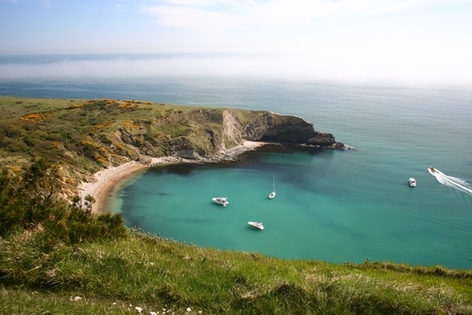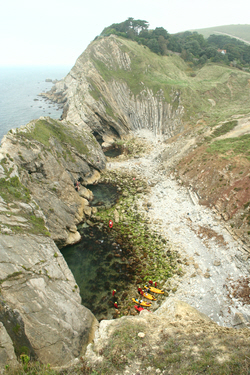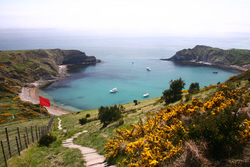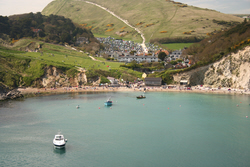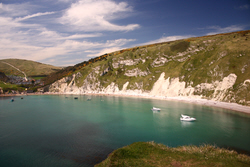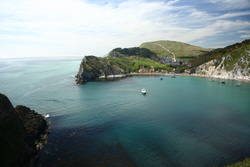Lulworth Cove...
|
Lulworth Cove is one of Dorset’s most picturesque and popular coastal haunts.
Carved out of the rocky coastline purely by the action of the sea, it is also one of several characteristic geological features in the area. Others include Stair Hole, the iconic Durdle Door and the “Fossil Forest”. Lulworth Cove, itself, is to the seaward side of the small village of West Lulworth and a few miles from Lulworth Army Camp. Had it not been requisitioned by the War Office during the Second World War, it is easy to imagine that the nearby “lost” village of Tyneham, might have grown into something similar - a small, rural, secluded, coastal village and tourist favourite. Lulworth Cove is almost completely enclosed and near-circular apart from its narrow entrance. As natural harbours go, it is small but perfectly-formed and has been used by fishing boats, pleasure craft and even passenger vessels running services to other ports of call on the Dorset coast. These are largely tourist services, but this is an area where even tourism has a long history! Steam boats were once frequent visitors to Lulworth Cove and are not unknown today! Lulworth Cove was formed by the sea breaking through a comparatively thin layer of hard Portland Stone that runs parallel to the shoreline. Once through, the action of the waves allowed much softer clays to be eroded more rapidly and extensively. And, as any school-kid physicist will tell you, when a straight wave hits a barrier with a hole in it, the resulting wave pattern on the other side is semi-circular. If you don’t believe it, go to Lulworth Cove and see it for yourself! The curved waves radiate out from the Cove entrance showing very clearly how Lulworth got it’s shape. If physical geography and geology is your thing there’s lots more to look out for in and around Lulworth. To the West of the Cove entrance and a short walk along the cliff tops you’ll find Stair Hole. In fine weather this is just a small hole in a big rock through which gentle waves lap and play. In rougher weather on the other hand, it’s a great place to see the force of the sea and, in particular, the impact of hydraulic action -waves forcing water into small holes in the rocks and, over time, making the holes bigger and longer until they break out the other side. Taken together, Stair Hole and Lulworth Cove are the sea’s equivalent of “this is one I made earlier”. One day, Stair Hole will also develop into a cove like Lulworth and probably merge with it. But don’t hold your breath, you’ll need to be a Time Lord to see it. What you can see today, both in Stair Hole and Lulworth Cove, is the fascinatingly folded layers of rock that form the ridges that have made this stretch of coastline so characteristic. Looking across the cove from the beach near its entrance to the sea gives a particularly good view of the rock strata, which are tilted to about 45 degrees. For those who want to know more about how the cove formed and the area’s geology, there’s a substantial visitor centre along with a café and souvenir shops. This also provides lots of information about the history of the Lulworth Estate on whose land the you’ll be standing. Apart from the Cove itself and the Visitor Centre, there’s a semi-pedestrianised walk which goes from the car park and visitor centre down to the cove. It is rich with places to refresh yourself or buy mementoes. The car park is substantial, but you do need to pay and display. But it is worth it as there’s lots to do, for those with the energy to do it. You could, of course, just use a visit to Lulworth Cove as another visit to the beach (this one’s pebbly with rock pools in places at low tide). But there are also walks Eastward, when the gunnery Ranges are open, and Westwards along the South West Coast Path to Durdle Door. You should be aware though, that this is not an area for the faint- or weak-hearted walker. The route to Durdle Door, for example, rises from just above sea-level to 134 metre in less than half a mile. The path is faced with stones, but these can be slippery when wet (scarily so) and there are steps... A lot of steps. And don’t forget, if you’re going down to Durdle Door, you have to make the climb twice, once there and again on the way back! Nevertheless, if you’re up to it, the rewards are spectacular!...But remember to take anything you think you’ll need with you. It is a long, hard trek back for the forgetful, the thirsty or the hungry!...Oh, and make sure you “go” before you go... |
Lulworth Cove is one of Dorset’s most picturesque and popular coastal haunts. "
|
